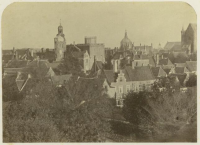Table of Contents
The Observatory on top of the Academy building
Founding of the Observatory
When Willebrord Snellius died in 1626, Jacob Golius who was professor of Oriental language was assigned as the new professor of Mathematics and Astronomy . Like Snellius, he was a very enthusiastic astronomer. After Snellius's died, Golius bought a big quadrant from Snellius's heritage (125 gulden) and this, together with Snellius's astronomical research which he had done with his personal instruments, led to the foundig of Leiden observatory in 1633.1)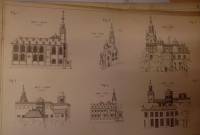
The observatory was housed in the academy building which meant the observatory became publicly accessible, thus continuously plagued by curious people. In Kaisers book2) we can read how he tells about Johannes Lulofs's (Rector magnificus 1755-1756) time in the observatory, whose attempts at doing any work were constantly interrupted by visitors asking stupid questions and disrupting his measurements.
Lulofs was succeeded by Dyonisius van de Wijnpersse, who according to Kaiser killed astronomy in Leiden. Not only was no progress made in the field during his directorship, the observatory also deteriorated into a state worse than even at the very beginning of the observatory. Dyonisius not only neglected his work, but also the instruments, rendering them useless after his term. The most famous case here is the Van der Wall reflector, which was the largest telescope in the country during Dyonisius's term and a rusted and corroded shadow after.
The observatory on the Academy building (1633-1860)
 The observatory housed on top of the Academy until 1861. Several platforms were erected for that purpose. However, these facilities were only meant for quick observations and demonstrations and no actual proper research could be done there.
The observatory housed on top of the Academy until 1861. Several platforms were erected for that purpose. However, these facilities were only meant for quick observations and demonstrations and no actual proper research could be done there.

 Up to Kaiser’s time astronomy was not even a research subject. Yet, teaching was reasonably up to date with current knowledge of astrometry, time determination, navigation and philosophy. E.g. Golius was aware of Galileo Galileï’s offered “invention” to use Jupiter's satellites as timing source for longitude. Tycho Brahe’s activities were known from first hand. But independent observations were seldom made. Either because of lack of interest of the astronomer, or because of lack of support from de University curators.
Kaiser changed this whole situation. He was crucial in lifting astronomy in Leiden to the European level.
Up to Kaiser’s time astronomy was not even a research subject. Yet, teaching was reasonably up to date with current knowledge of astrometry, time determination, navigation and philosophy. E.g. Golius was aware of Galileo Galileï’s offered “invention” to use Jupiter's satellites as timing source for longitude. Tycho Brahe’s activities were known from first hand. But independent observations were seldom made. Either because of lack of interest of the astronomer, or because of lack of support from de University curators.
Kaiser changed this whole situation. He was crucial in lifting astronomy in Leiden to the European level.
De komeet van Halley verschijnt boven Nederland
The diary of student Nicolaas Beets, (visiting the observatory, on the roof of the Academy building, to observe the comet of Halley through the reflector of Rienks and Roelofs.):
Vrijdag 16 oktober (1835. De komeet z.g. van Halley is aan den hemel zichtbaar. Ik wandel in den avond met Kuffeler naar het Academiegebouw om te zien of er geen mogelijkheid is op het observatorium te komen. Op de plaats ontmoeten wij Prof. Uylenbroek zelf met een lantaren in de hand, zich gereed makende derwaarts op te stijgen. Hij is zeer wel willend om ons mede te nemen. Boven, een heerlijk schouwspel. De sterrenhemel helder en heerlijk. Ik zie niets dan zijne oneindigheid. Beneden, laag beneden, onder een opstijgenden nevel bedolven, ligt de stad en het landschap met zijn poppespel van straatlantaarns en huis-lichtjes, waarnaar ik geen lust heb om te zien. Ik verlies mij in den aanblik der blinkende onmetelijkheid. 't Is alles stil; slechts nu en dan het stenen van een uil. O Hoe gaarne had ik daar eenigen tijd, geheel alleen op en neer getreden en gemijmerd. [….]
Maar nu moest ik de komeet van Halley zien. Ik bekeek hem door de teleskoop van Rienks, die er zelf bij stond in zijne eenvoudig boerenkleeding; maar zag er niet veel meer van dan met het blote oog, dat er mij genoeg van zien liet om mij tot bewondering en stille aanbidding van den grooten Schepper er Verordineerder te doen verzinken.
Een half uur bleven wij op het Observatorium. Het gelaat des hemels veranderde. Dampen, wolken, en zwarte duisternis betrokken het. Triviale nevelen ontrukten ons de aanblik der sublieme sterren. Ook de komeet was weldra aan ons oog onttrokken. De schitterende ster, die een straal licht voor zich uitwerpt die wij op 20 millioenen afstands een uitgestrektheid van 3 a 4 ellen aan den hemel zien beslaan en die van de Kroon tot bijna aan den Melkweg reikt, wordt door onzen laagzwevenden aardschen dampkring voor onze oogen verduisterd & bedekt. Zoo gaat het tusschen wat uit de aarde aardsch en wat hemelsch is. Ook tusschen een benevelde kritiek en een schitterend genie.
Other
Bij de in den tekst volgende beschrijving van de Leidsche sterrenwacht vgl. men Uffenbach, Reisen etc. III blz. 396-398 en de daarbij behoorende teekeningen, fig. XIV-XVI, en de Geschichte der Astronomie und der Sternwarte an der Universität in Leiden van Prof. Dr. F. Kaiser, in Annalen der Sternwarte in Leiden, Erster Band, S. I-XVI. Ferrner's beschrijving van de Leidsche sterrenwacht in 1759 is o.a. hierom van belang, omdat zij (althans voor 1759) bevestigt de mededeeling van Kaiser t.a.p. S. XII-XIII, dat de afbeelding der sterrenwacht bij van Mieris (verschenen in 1762-1770) onjuist is. Op de plaat bij van Mieris bestaat de sterrenwacht uit één, tamelijk groot gebouw, met een vlak dak, dat zich boven het dak van de academie verheft. Kaiser is echter tot de conclusie gekomen, dat van 1689 tot 1817 de sterrenwacht heeft bestaan uit twee kleine, houten torentjes met een houten platform, waar de waarnemingen geschiedden, en uit de zoogenaamde ‘lange zaal’, waar de instrumenten bewaard werden; op de dakgoot van deze ‘lange zaal’ rustten de houten palen, die het evengenoemde platform droegen. Ferrner's verhaal van den toestand in 1759 stemt hiermede overeen; wanneer men zich precies voor oogen wil brengen wat hij beschrijft, raadplege men fig. 3 op de eerste plaat achter Annalen etc. I.
Ferrner's visit 1759
 Bengt Ferrner, a Swedish astronomer wrote about the Leiden observatory in his diary. He describes how the observatory looked and what it was equipped with in 1759. He is generally very positive about his experience.
Bengt Ferrner, a Swedish astronomer wrote about the Leiden observatory in his diary. He describes how the observatory looked and what it was equipped with in 1759. He is generally very positive about his experience.
The relevant diary part starts on the 22th of June in the Hortus, where Ferrner is shown various biological wonders but is not so much impressed. He described the garden as “The Hortus Botanicus was in good condition, but not as big nor as well arranged or maintained as in Upsala. I also don't believe that there are as many different plant species present as in the academical garden in Upsala, but I can't say this for sure.” The story then picks up with Ferrner meeting Prof. Lullofs: 3) “
Prof. Lullofs recieved me with exceptional politeness and, after a short conversation, took me to the observatory that was on top of the academy building. On the third floor, on the south side, was a room for a transit instrument4), the meridian and a clock. The transit instrument was of good making, and judging superficially, firmly placed. (However, the axis was not as long as in Ekstrom's5) design in the Upsala Observatory. The sundial was not as large as in Upsala. Also present were a couple of copper plates, ready to put on the meridian on the ground and on the wall, where the meridian was precisely cut into the wood, but they were not yet installed.
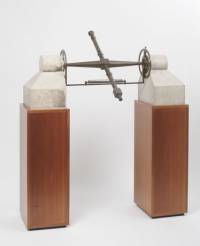
 The clock was made in Leiden, and Lulofs was very proud of it. It did not have a compact pendulum as described by Graham, but it had a spring for winding. I have never seen such a clock, that according to Lulofs was only recently invented in England. This spring enabled the user to change the length of the pendulum at will, without stopping the clock in the process. One needed only to turn a separate clock hand on the clocks face. The face had certain markings which told the user by how much he had changed the length.
The clock was made in Leiden, and Lulofs was very proud of it. It did not have a compact pendulum as described by Graham, but it had a spring for winding. I have never seen such a clock, that according to Lulofs was only recently invented in England. This spring enabled the user to change the length of the pendulum at will, without stopping the clock in the process. One needed only to turn a separate clock hand on the clocks face. The face had certain markings which told the user by how much he had changed the length.
Opposite from this room was a second one, one that served as storage for old and useless instruments, globes and other objects. From this room we went on to the roof of the Academy building, where the observatory was. Consisting of two wooden houses, one larger and the other smaller, which stood on the sloping roof and were supported by wooden beams, that did not look extremely sturdy. Lulofs admired that he could not be sure of the accuracy of his observations when there were people on the roof.6) In the large wooden shack, that was so low, that one could touch the roof with his hand, and that had hatches all around, which could be opened at will, were mirrors for two telescopes of 7.5 foot. One was made by Short in London and the other by Hearne7) in Franeker. The mirror by Short was dimmer and of lesser quality, but the difference turned out to be not a big as it seemed. These mirrors were so similar of size, that the same tube and setup could be used for both.
There was also an old pendulum clock by Huygens there, kept as a rarity. It was commissioned by Huygens, who supervised the assembly. There was also his8) 309) foot telescope, the longest telescope that the observatory possessed. The quadrant with a 7 foot radius was made out of wood, except for a copper edge. This quadrant was very old and of little significance.10) In this room there were several other small items not worth a description, apart from a objective glass of 100 foot by Hartsoecker11), who had made it himself and donated it to the observatory. However the observatory gave him 50 ducats back, as a gift.
In the smaller hut there was a composite instrument that was being stored there, that 's Gravesande had commissioned and described in his work. It was a conjunction of different astronomical instruments, like a machina parallactica aequatoria12), a quadrant, a micrometer and so on. It was constructed in such a delicate and complex way that it was very unstable, and therefore completely unusable. Lulofs was 'S Gravesandes successor and said; “egregius erat physicus, sed astronomiae parum peritus”13) in response to this instrument.14) Lulofs complained greatly about not having much time for astronomy, because besides that he also had was a professor in logic, metaphysics and natural law15). He was also one of the directors of this countries canal works16), something which, according to him, takes about the same amount of time as his professorship, but also offers the same pay. Lulofs seemed young and joyful, however he was 47 years old. Because it had grown late, Lullofs promised to show me his observations of the recent comet some other time. He escorted me to my lounging quarters. “
Bugges Visit 1777
[ ]In his diary17) Thomas Bugge, a danish astronomer from the 18th century visits the Leiden observatory, here he describes meeting Dyonisus van Wijnperse in august 1777. In this journal he describes the observatory as consisting out of 2 parts, a lower part in the attic of the academy building and an upper part on the roof. He confirms Kaiser's accusations of Van Wijnperse being uninterested in astronomy, as the overall image that Bugge sketches is one of neglect.
]In his diary17) Thomas Bugge, a danish astronomer from the 18th century visits the Leiden observatory, here he describes meeting Dyonisus van Wijnperse in august 1777. In this journal he describes the observatory as consisting out of 2 parts, a lower part in the attic of the academy building and an upper part on the roof. He confirms Kaiser's accusations of Van Wijnperse being uninterested in astronomy, as the overall image that Bugge sketches is one of neglect.
From his diary18): “The lower observatory is nothing bit a long corridor with a window at one end towards the south. Here a transit instrument of about 2.5 feet was placed. It was of rather old fashioned construction, dating from the time of 's Gravesande.19) Besides this instrument, placed on the pillar AB, was an equal altitude instrument, it was rather good and made by Paauw.20)
What I found very curious is that the transit instrument is removed from its bearings and placed in a case. Nor was there any spirit level to set the axis horizontally. In the lower observatory there is another room where several old and rather useless instruments are kept; a sector of 4 feet radius, old globes, planetariums, wooden quadrants and a 20' objective by Hartsoeker 1868. 21) The best thing was an original Rhineland foot, however the points division were rather rough.
The upper observatory ABCD consists of the southern observation platform EFGHQP where there is a roundish building EFGA with a movable roof. It was intended to house a movable quadrant. The construction of the support is rather unfavorable and unsteady. The quadrant itself was hidden in the house IKMN in a box a. Its radius was 1.5 feet, and it was mounted with two telescopes, one of them movable. The edge was divided into whole degrees. And by wheelwork the degrees were subdivided into minutes and seconds largely according to Hooke's methods. In the same building there was a 7-foot rNewtonian reflecting telescope (b) by Hearne, London.(The tube is of wood. The telescope is very good)22) It had two objective glasses and two plane mirrors and Bradley's micrometer. In c and in d are several supports for the telescope. Mr. Wijnperse told me that at an elevation of more than 30 degrees it was difficult to make observations. The error is due to the support, which was , in a certain way, nothing but trestles.
OPHQ is a seprate house with a movable (but leaky) roof, which houses an old-fashioned 4' quadrant. (Made out of wood and the edge of brass.) A 4 foot radius with a small azimuth circle of about the following arrangement. KDBLM is the northern observation platform. There are only two clocks and one of them goes only one a day, and the other has no compound pendulum, and is moreover very bad in all respects.“
Other descriptions
Bugge also describes his visit to the university library, where he sees the Tracy Planetarium23) and describes it as a very beautiful piece. In the Hortus, which he describes as very well kept, he describes a cabinet of natural objects. He is impressed with the content, neatness and cleanliness, even though it is about half the size of the Copenhagen cabinet. (He also admits to not be knowledgeable of the subject) After that he describes a skeleton which is on display. This is the skeleton of a traitor, who would surrender Leiden to the Spaniards. It wore a wig and a Crispen collar and a pair of the emperor Charles V's boots.24)


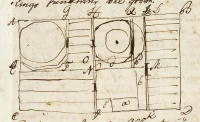
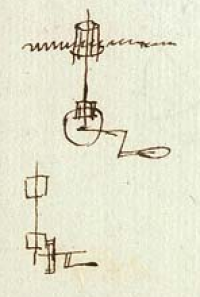
![This is of course [[telescopes:quadrant_snellius|Snells' Quadrant]] This is of course [[telescopes:quadrant_snellius|Snells' Quadrant]]](/~kaiser/wiki/lib/exe/fetch.php?w=200&tok=c49125&media=history:bugge4.png)
